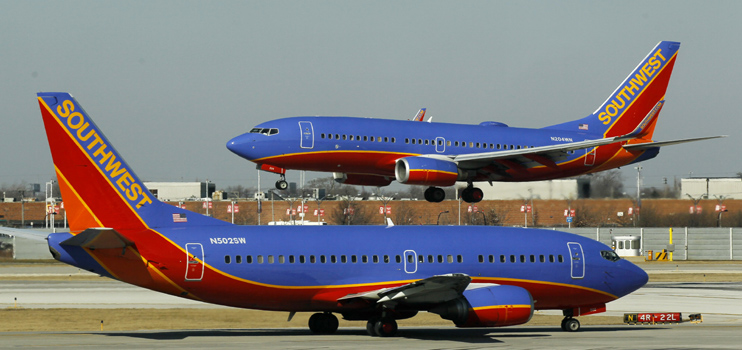Southwest's amazing safety record
15 May, 2014
8 min read
By joining our newsletter, you agree to our Privacy Policy


In the 43 years it’s taken for Texas based Southwest Airlines to grow from an irreverent, upstart carrier to the largest domestic airline in the United States it has suffered a sole safety-related fatality. Beneath the fun and frolic that characterize the Southwest’s public persona there’s a no-nonsense - and serious - culture of safety that saves lives.
To fully fathom how remarkable the single safety-related fatality is you’ve got to consider that over the first 42 years of its 43-year existence, the period for which we have complete numbers, Southwest transported some 1.7 billion passengers – 1,708,515,297 to be precise. During the same timeframe it made 23.9 million trips.
See passenger reviews for Southwest Airlines
The record is exemplary, but not without blemishes. It was at Chicago Midway, on December 8, 2005, that Southwest recorded its only death related to safety issues. A young boy died when Flight 1248 skidded off the runway and hit the vehicle in which he was riding.
In a separate incident on August 11, 2000 a passenger died of his injuries when fellow passengers restrained him after he broke through the cockpit door.
The carrier’s closest call to full-blown catastrophe came March 5, 2000, when Southwest 1455 overran the runway at Burbank, California injuring 43. Bill Waldock helped investigate the accident. “The bottom line…is that if you land an airplane long (too far down the runway) on a very short runway, and it’s 29 knots too fast, you’re probably going off the end,” says the professor of safety science at Embry-Riddle Aeronautical University in Prescott, Arizona. Waldock is also director of the Harry Robertson Aircraft Accident Investigation Laboratory.
July 22, 2013 Southwest 345 landed at New York LaGuardia nose-gear first and it collapsed with ten people on board suffering minor injuries.
Other major occurrences include a couple of aircraft structural problems that hit the headlines. July 13, 2009 and April 1, 2011 respectively a pair of the carrier’s 737-300s sprouted holes in the tops of the fuselage. Both aircraft landed safely.
That’s not the whole Southwest accident/incident record, but it’s the most notable. “They’ve never actually had a catastrophic accident,” says Waldock. So, is Southwest merely lucky? The evidence certainly argues otherwise.
The carrier’s safety culture is rooted in a pervasive, persistent sense of what constitutes the common good. “It started out, really, many years ago when [co-founder] Herb Keller was chairman,” says the Embry-Riddle safety professor. “His philosophy was that everybody is a part of safety…that if you were a part of the Southwest family you had responsibilities to the rest of the family” to shepherd the airline’s safety, tend to the common good.
Kelleher’s concept still holds. In its Safety Commitment statement the airline asserts, “All Southwest Airlines Employees, from Leadership to Frontline Employees, are responsible for establishing the highest level of Safety in our operation and workplace.”
It’s easier to label your company a ‘family’ affair when it’s relatively small; harder – perhaps – after it’s all grown up and spread its wings. Southwest has 45,400 employees and fields 3,600 flights per day via 600-plus airplanes. That’s a staggering 1.31 million flights a year!
Critical safety culture components
Leadership, selective hiring, employee engagement and fleet commonalty underpin Southwest’s safety efforts. “Any or all of those contribute to good safety culture,” says Paul Hayes director of air safety and insurance for Ascend Worldwide, a major international aviation safety data supplier. Hayes indicates one of these qualities is critical. Safety culture “comes from the top, the CEO.”
In that regard, present CEO Gary Kelly carries on Kelleher’s concepts. One key component of Southwest’s (as well as other carrier’s) safety culture is a non-punitive reporting system called ASAP – the Aviation Safety Action Program. A U.S. Federal Aviation Administration initiative, it allows an employee to report a mistake without fear of getting in trouble.
FAA says ASAP’s purpose “is to encourage air carrier and [maintenance] repair station employees to voluntarily report safety information that may be critical to identifying potential precursors to accidents.” The essence of it is this simple: sunshine can stop small problems from becoming large, life-threatening ones by creating “a non-threatening environment that engages[s] the employee to voluntarily report safety issues.”
“Most carriers have adopted systems that are non-punitive,” says Waldock. Upon reporting the misstep, “You may have to go back for remedial training. But that way you find out what [the] problems are [so] you can fix them before they get out of control.”
Another cultural concept at Southwest is taking your job, but not yourself, seriously. Professor Alex Rodriguez-Ginorio of the Metropolitan Campus of the Inter American University of Puerto Rico says in his organizational analysis of the airline that culture means maintaining a formal organization “that offers flexibility, empowerment and a notion of fun regarding the employees’ work environment.”
Case-in-point: those boring, ponderous pre-takeoff safety announcements – the ones that cover emergency oxygen use and how to evacuate the airplane fast. Southwest understood canned safety briefings don’t really focus flyers’ attention. They cause some folks, in fact, to tune out. That’s what helped give birth at Southwest to announcements such as this: “Put your oxygen mask on first. Then put the mask on your child – or on someone who’s acting like a child.”
In written response to a question from AirlineRatings.com, Southwest says, “As long as all of the Safety and regulatory requirements are met, our Flight Attendants are encouraged to make onboard Safety briefings engaging through the use of humor, song, or other individual twists. One example of this is Flight Attendant Marty Cobb, who recently made a splash when her comedic pre-flight briefing went viral (See video below). Marty is just one example of the fun-loving spirit that Southwest Employees exhibit every day to further enhance our Safety Culture.” The comedy comes with a purpose. People chuckle, and that reinforces the potentially life-saving message.
Imagine for a moment the worst flight attendant you’ve ever encountered, the rudest gate agent. It’s highly likely they didn’t work for Southwest Airlines. “The organizational culture encourages employees to be prepared to offer help at any moment,” writes Rodriguez-Ginorio. “Pilots will help flight [attendants] check in passengers, and off-duty employees, like a foreman of ground equipment, assisted a flight attendant tend a food poisoning passenger.” The foreman later helped that same passenger claim her luggage.
Corporate culture, the culture of the collective, of ‘we, not me,’ is inseparable from safety culture. They’re woven of the same cloth.
The interview phase of Southwest’s interview process is decidedly different from many carriers. A sense of humor is almost imperative. Applicants tell jokes, role-play and are – in part – judged on their teamwork and spontaneity. It’s all part of the personnel package.
While Southwest’s people may be spontaneous and diverse, its fleet is neither. As of December 31, 2013 the combined Southwest/AirTran fleet (Southwest merged with its low-fare rival) totaled 680 twinjets: 122 737-300s, 15 737-500s, 425 737-700s, 52 737-800s and 66 717-200s. It’s the latter that are odd-man-out. The 717 is basically an updated, high-tech version of the venerable Douglas DC-9. It’s not a fit in Southwest’s scheme of things. That’s why the carrier is leasing or sub-leasing all of AirTran’s ‘seven-ones’ to Delta Air Lines. The 717 is, in effect, a replacement aircraft for Delta’s now-retired DC-9s.
Shedding its 717s makes standardization of pilot training, pilot scheduling and maintenance “a lot easier,” says Bill Waldock. Talk to any safety expert and they’ll tell you standardization begets simplicity – and simplicity makes for a safer operation. “One of the hallmarks of the Southwest operation is that they were a single-airplane type operator,” says Waldock. “The 737 was their airplane.”
The challenge to be even better
Once it’s established, the most persistent challenge in maintaining a good safety culture is complacency. “You’ve got to keep working at [safety],” says Paul Hayes, “and it’s got to be at all levels. You can’t take it for granted.”
Just now, despite the high-profile disappearance of Malaysia Airlines Flight 370, the safety record of the world’s airlines is solid. Recently-released 2013 data by the International Air Transport Association underscores just how safe commercial aviation continues to be. Some 3 billion-plus passengers flew safely last year aboard 36.4 million flights. There were 81 accidents in all during 2013. That’s 6 more than in 2012, but still below the five-year average of 86. There were 210 fatalities worldwide in 2013, down from 414 in 2012. That’s far short of the five-year average of 517.
Boeing’s Current Market Outlook 2012 – 2032 shows 20,210 jet airliners in service in 2012 and 41,240 by 2032 – more than double the number. The implications for safety according to Hayes are elementary. “If the level of safety remains the same – doesn’t deteriorate, but just remains the same – you’ll get twice as many accidents…The industry has got to improve its safety. And in 10 or 15 years it’s got to be twice as good as it is today.”
Southwest helped set the safety bar high. But today’s overall industry safety record – as good as it is – is just not good enough. Over the next few years the airline industry is going to have to hoist that bar even higher. Developing a deep-rooted, safety-first culture is where it all begins. Taking a few cues from Southwest Airlines isn’t a bad place to start.
Next Article
Qantas triples profit but misses mark

Get the latest news and updates straight to your inbox
No spam, no hassle, no fuss, just airline news direct to you.
By joining our newsletter, you agree to our Privacy Policy
Find us on social media
Comments
No comments yet, be the first to write one.
